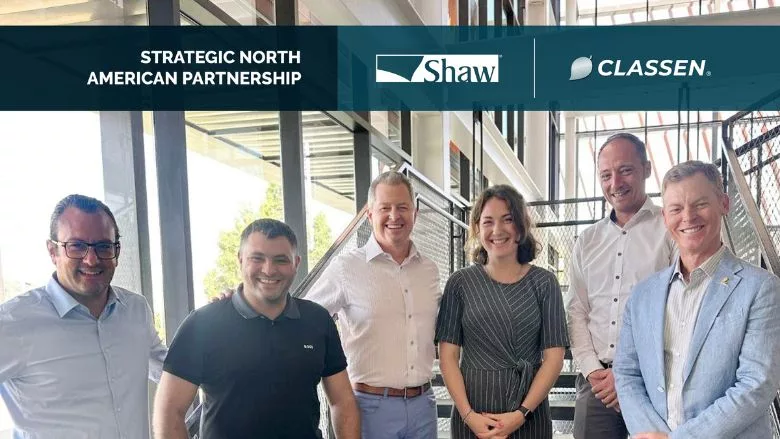Industry Q&A
Shaw EVP Kelley Fain on the Increasing Demand for PVC-Free Flooring

From left: Dr. Moritz Menier, CEO, Classen Americas; Patrick Pfisterer, project manager, Classen; Kelley Fain, EVP - Commercial Division, Shaw; Celine Quervel, marketing manager, Classen Group; Patrick Pohl, head of product management & design development, Classen Group; Scott Sandlin, EVP, residential division, Shaw.
Shaw Industries recently announced a strategic partnership with the Classen Group, a hard surface flooring manufacturer based in Germany that offers PVC-free solutions for commercial and residential environments. Through this partnership, Shaw will become the sole distributor of the company’s new commercial flooring products in North America.
We caught up with Kelley Fain, EVP of Shaw's commercial division, to discuss PVC-free flooring products and demand in the marketplace.
FLOOR Trends & Installation: How did the partnership with Classen Group come about?
Kelley Fain: We're always looking for partners that share our values for not just sustainability, but also design quality performance, and they just checked all the boxes. We've known about Classen for quite some time, and they've been a leader in the field of innovation. And so we started talking to them about this opportunity and looking at their PVC-free product and came about the exclusivity for North America. So it's pretty exciting.
FLOOR Trends & Installation: What are you seeing in terms of demand for PVC-free flooring in the North American market?
Fain: We've seen a number of market signals and indicators that have pointed to the opportunity for more PVC-free flooring options in the market. We saw large architect design firms that in the past 18 months have removed PVC product from their product libraries. They're a growing group that would like to see more PVC-free solutions. I think about the healthcare segment where we've seen explosive growth, and there are product certifications like Greenhealth Approved, and those require products to be PVC-free. We've seen demand grow in our bio-based resilient, and that was the first resilient flooring product to be Greenhealth Approved. When I look back at our EcoWorx journey with EcoWorx carpet tile—we launched that more than two decades ago—and it was the first PVC-free and fully recyclable carpet tile in the industry. It's really been explosive for us.
FLOOR Trends & Installation: What are you seeing in terms of demand for PVC-free flooring in the North American market?
Fain: They look for multiple attributes in sustainability. Those would be material health, that's an area where we want to continue to lead the industry, and material health and wellness. The other is how we use recycled content and the circularity of the product, the ability for it to be recycled at the end of its useful life. We have a program called re[Turn] that applies not only to our EcoWorks carpet tile, but we'll also apply to our LVT or the PVC-free product that we produce with Classen. Low carbon footprint is important, and there are a variety of other things as well.
Fain: When you're trying to innovate, the big piece is material health. Our Shaw Contract team talks about neutral is not enough, meaning carbon neutral. We've got to do more than just focus on the carbon footprint. There's the materiality, there is the circularity, and just the overall health and wellness of your product, and we're focused on people and the planet and to be as simple as possible and how we impact and create better futures for both.
FLOOR Trends & Installation: What type of education will be required for this new collection of PVC-free flooring?
Fain: With any product introduction, it's our job to clearly communicate the benefits of that product to the end user, and not just the end user benefit, but also how it benefits the installer, how it benefits the specifier, what their strategic goals and priorities are. So we focus on all the channels and segments and everybody that this product can benefit, and this non-vinyl product intro won't be any different than how we educate with all of our other product introductions.
FLOOR Trends & Installation: What markets will benefit from this partnership?
Fain: You think about the specifiers and the designers, and they have their own strategic priorities, and we've sought to better understand and work market backward the problems that they're trying to solve for their clients. And certainly this partnership with Classen checks that box. Also with the end user, what their ESG goals are, and the circularity component of this is going to fill that need and solve that challenge for them. I think also when you combine flooring— you see a lot of carpet tile and LVT installations together with a seamless installation where you have no transition strip. This idea of mixed materials in a space that can all be sustainable, that certainly solves lots of problems.
Looking for a reprint of this article?
From high-res PDFs to custom plaques, order your copy today!



